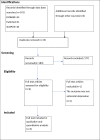Prevalence and determinants of antenatal depression in Ethiopia: A systematic review and meta-analysis
- PMID: 30779765
- PMCID: PMC6380851
- DOI: 10.1371/journal.pone.0211764
Prevalence and determinants of antenatal depression in Ethiopia: A systematic review and meta-analysis
Abstract
Background: Maternal depression is the most prevalent psychiatric disorder during pregnancy, can alter fetal development and have a lasting impact on the offspring's neurological and behavioral development. However, no review has been conducted to report the consolidated magnitude of antenatal depression (AND) in Ethiopia. Therefore, this review aimed to systematically summarize the existing evidence on the epidemiology of AND in Ethiopia.
Methods: Using PRISMA guideline, we systematically reviewed and meta-analyzed studies that examined the prevalence and associated factors of AND from three electronic databases (PubMed, EMBASE, and SCOPUS). We used predefined inclusion criteria to screen identified studies. A qualitative and quantitative analysis was employed. Heterogeneity across the studies was evaluated using Q and the I² test. Publication bias was assessed by funnel plot and Egger's regression test.
Results: In this review, a total of 193 studies were initially identified and evaluated. Of these, five eligible articles were included in the final analysis. In our meta-analysis, the pooled prevalence of AND in Ethiopia was 21.28% (95% CI; 15.96-27.78). The prevalence of AND was highest in the third trimester of pregnancy at 32.10% and it was 19.13% in the first trimester and 18.86% in the second trimester of pregnancy. The prevalence of AND was 26.48% and 18.28% as measured by Beck depression inventory (BDI) and the Edinburgh Postnatal Depression Scale (EPDS), respectively. Moreover, the prevalence of AND was 15.50% for the studies conducted in the community setting and it was 25.77% for the studies conducted in the institution-based setting. In our qualitative synthesis, we found that those pregnant women who had a history of stillbirth, complications during pregnancy, previous history of depression, no ANC follow-up, irregular ANC follow-up, not satisfied by ANC follow-up, and monthly income <1500 Ethiopian birr were linked with a greater risk of developing ANC. We also found that those women who experienced partner violence during pregnancy, food insecurity, medium and low social support, and those who were unmarried, age group 20-29, house wives and farmers were associated with a higher risk of developing ANC.
Conclusion and recommendations: Our meta-analysis found that the pooled prevalence of AND in Ethiopia was 21.28%. The prevalence of AND was high in the third trimester of pregnancy as compared to the first and second trimesters of pregnancy. The prevalence of AND was high in studies conducted using BDI than EPDS. Studies on the magnitude of AND as well as the possible determinants in each trimester of pregnancy with representative sample size are recommended. Screening of depression in a pregnant woman in perinatal setting might be considered backed by integration of family planning and mental health services. The use of validated and a standard instrument to assess AND is warranted.
Systematic review registration: The protocol for this systematic review and meta-analysis was registered at PROSPERO (record ID=CRD42017076521, 06 December 2017).
Conflict of interest statement
The authors have declared that no competing interests exist.
Figures
Similar articles
-
The epidemiology of postnatal depression in Ethiopia: a systematic review and meta-analysis.Reprod Health. 2020 Nov 19;17(1):180. doi: 10.1186/s12978-020-01035-1. Reprod Health. 2020. PMID: 33213434 Free PMC article.
-
Prevalence of antenatal depression and associated factors among pregnant women in Addis Ababa, Ethiopia: a cross-sectional study.Reprod Health. 2015 Oct 30;12:99. doi: 10.1186/s12978-015-0092-x. Reprod Health. 2015. PMID: 26514827 Free PMC article.
-
A systematic review and meta-analysis of epidemiology of depression in people living with HIV in east Africa.BMC Psychiatry. 2018 Aug 15;18(1):254. doi: 10.1186/s12888-018-1835-3. BMC Psychiatry. 2018. PMID: 30111300 Free PMC article.
-
Depression during pregnancy and associated factors among women in Ethiopia: a systematic review and meta-analysis.BMC Pregnancy Childbirth. 2024 Mar 26;24(1):220. doi: 10.1186/s12884-024-06409-y. BMC Pregnancy Childbirth. 2024. PMID: 38532382 Free PMC article.
-
First trimester antenatal care contact in Africa: a systematic review and meta-analysis of prevalence and contributing factors.BMC Pregnancy Childbirth. 2023 Oct 19;23(1):742. doi: 10.1186/s12884-023-06034-1. BMC Pregnancy Childbirth. 2023. PMID: 37858033 Free PMC article.
Cited by
-
Antenatal Depression and Associated Factors among Pregnant Women Attending Antenatal Care Service in Kochi Health Center, Jimma Town, Ethiopia.J Pregnancy. 2021 Feb 8;2021:5047432. doi: 10.1155/2021/5047432. eCollection 2021. J Pregnancy. 2021. PMID: 33628509 Free PMC article.
-
Depression and anxiety among pregnant women during COVID 19 pandemic in Ethiopia: a systematic review and meta-analysis.Front Glob Womens Health. 2024 Dec 3;5:1453157. doi: 10.3389/fgwh.2024.1453157. eCollection 2024. Front Glob Womens Health. 2024. PMID: 39691679 Free PMC article.
-
Fear, anxiety and depression among pregnant women during COVID-19 pandemic: impacts of healthy eating behaviour and health literacy.Ann Med. 2021 Dec;53(1):2120-2131. doi: 10.1080/07853890.2021.2001044. Ann Med. 2021. PMID: 34761972 Free PMC article.
-
Prevalence and Associated Risk Factors of Antenatal Depression among Pregnant Women Attending Tertiary Care Hospitals in South India.Depress Res Treat. 2022 Nov 17;2022:9127358. doi: 10.1155/2022/9127358. eCollection 2022. Depress Res Treat. 2022. PMID: 36438017 Free PMC article.
-
Association between dietary intake and symptoms of depression and anxiety in pregnant women: Evidence from a community-based observational study.Food Sci Nutr. 2023 Sep 21;11(12):7555-7564. doi: 10.1002/fsn3.3675. eCollection 2023 Dec. Food Sci Nutr. 2023. PMID: 38107103 Free PMC article.
References
-
- Bennett HA, Einarson A, Taddio A, Koren G, Einarson TR. Prevalence of depression during pregnancy: systematic review. Obstetrics & Gynecology. 2004;103(4):698–709. - PubMed
Publication types
MeSH terms
LinkOut - more resources
Full Text Sources
Medical




